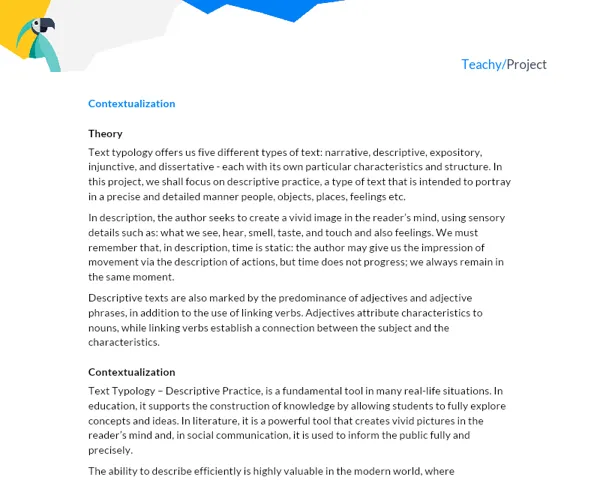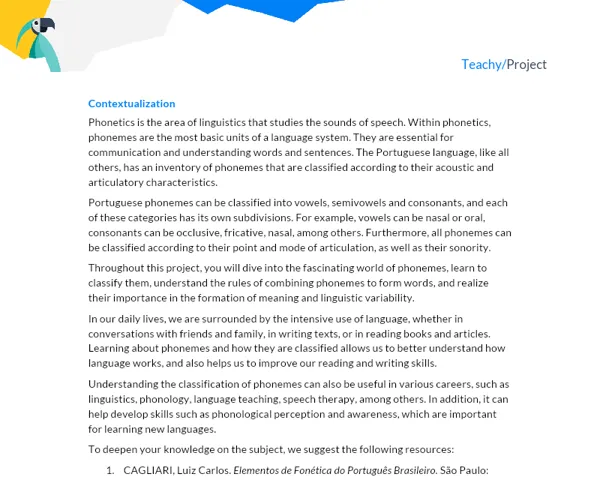Contextualization
The concept of 'intertextuality' was conceived by Julia Kristeva in 1966, in her theory that the production of any text is influenced by pre-existing texts, whether consciously or unconsciously by the author. Referential intertextuality is one of the six categories of intertextuality created by the linguist Gerard Genette and occurs when, in a given text (receiving text), we have an explicit reference to another text (source text). This reference can be a quotation, paraphrase, allusion, or any other type of direct reference to the content of an existing text. In practice, this means that, at the moment of text production by the author, there is a reappropriation of a part or a whole of an existing text.
In the world of literature, specifically, intertextuality is often used as a way to build upon existing works, pay homage or parody previous works, or simply to add layers of meaning to a text. Through intertextuality, authors can strengthen their arguments or enrich their stories, drawing on the reader's knowledge or their previous experiences with related texts. Intertextuality can also be used to create a connection between different texts, whether to reinforce an idea, contradict it, or simply to provide a different point of view.
The use of intertextuality is not limited to literary texts. It can be found in various forms of media, such as films, music, paintings, and even memes. Its importance lies in its ability to evoke feelings, create new perspectives, and expand the understanding of the content presented. Furthermore, identifying referential intertextuality in the texts we read is an important skill for our comprehension and interpretation of the messages conveyed.
For a deeper understanding of the topic, it is suggested to read the following resources:
- FARACO, Carlos Emílio. Linguagem & Diálogo: as ideias linguísticas do círculo de Bakhtin. 1st ed. São Paulo: Parábola Editorial, 2009.
- KRISTEVA, Julia. Introdução à semanálise. Translation by Ana Goldberger. São Paulo: Perspectiva, 1974.
- GENETTE, Gerard. Palimpsestes. Paris: Seuil, 1982.
- Castro Alves Virtual Library
Practical Activity
Activity Title: 'Referential Intertextuality in Cinema - An analysis of contemporary films'
Project Objective
The task aims to provide students with the opportunity to explore the concept of referential intertextuality in a non-traditional context: that of contemporary cinema. Additionally, they should develop skills in teamwork, critical analysis, research, and writing.
Detailed Project Description
In groups of 3 to 5 students, you will choose a contemporary film that uses referential intertextuality. Once the film has been chosen, the group should analyze the ways in which the film references other works, events, characters, etc. The choice of film is free, but it is recommended that it is one that everyone in the group has access to and feels comfortable discussing.
Required Materials
- Computer or device with internet access.
- Means to watch the chosen film (DVD, streaming, etc.)
- Paper and pen for notes.
Detailed Step-by-Step for Activity Completion
- Form a group of 3 to 5 students.
- Together, choose a film that you like and that has clear examples of referential intertextuality.
- Watch the film together (if possible) and discuss it.
- Make a list of all the references that the group can identify and survey the works, events, characters, etc., to which they refer.
- Group discussion to establish which of these references are most relevant or interesting for analysis.
- Research the filmmakers' intentions in using these references and how they contribute to the film as a whole.
- Write a group report detailing your findings.
Project Deliverables
To complete the project, your group must deliver a written report, structured as follows:
Introduction: In this topic, you should contextualize the chosen film, briefly introduce the theme of referential intertextuality, and justify the choice of the film.
Development: Here, you should address the concept of referential intertextuality in a more in-depth manner and discuss the references found in the film. Describe in detail the identified references, explain the works, events, etc., to which they refer, and discuss their role in the film. Also include the research methodology used by the group and the conclusions reached.
Conclusions: Summarize the main points discussed in the development, connect your observations with the theory studied, and highlight the learnings obtained during the project.
Bibliography: List all the research sources used by the group, whether for the film analysis or to support the theoretical concepts discussed.
The report should be typed, with a limit of 5 pages, and should use the ABNT standard for citations and references. Each group member should contribute to the report writing. The teacher will evaluate not only the content of the report but also the organization and cohesion of the text, clarity of arguments, and correctness of writing.



